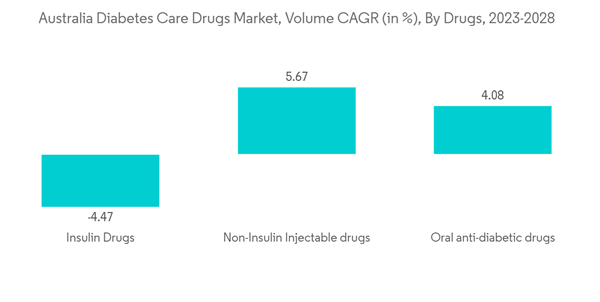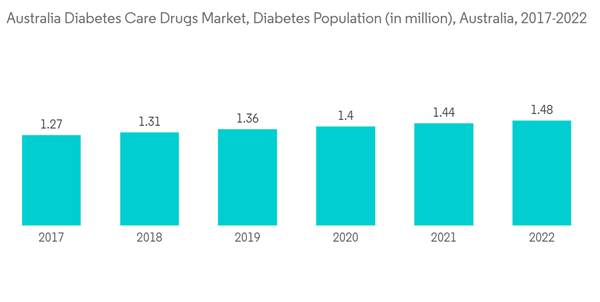The COVID-19 epidemic boosted the expansion of the Australia Diabetes Care Drugs Market. Diabetes patients infected with COVID-19 may have high blood glucose levels, irregular glucose variability, and diabetic complications. According to the Australian Government Department of Health and Aged Care, there have been 92,35,681 confirmed cases of COVID-19 in Australia since the pandemic's commencement in July 2022. Diabetes prevalence in adults with COVID-19 produced a substantial increase in COVID-19 severity and mortality in people with type 1 (T1DM) or type 2 diabetes mellitus (T2DM), particularly in connection with poor glycemic control. While new-onset hyperglycemia and diabetes (both T1DM and T2DM) have become more recognized in the setting of COVID-19 and have been linked to worse outcomes. To minimize aggravation, a patient's blood glucose should be checked and maintained on a regular basis, emphasizing the significance of diabetes care medicines.
Obesity, a poor diet, and physical inactivity are all contributing to a rise in the number of newly diagnosed Type 1 and Type 2 diabetes cases. The fast-rising incidence and prevalence of diabetes patients, as well as healthcare spending in industrialized nations, are indicators of increased use of diabetic care products. Furthermore, rising diabetes incidence and increased usage of insulin delivery devices are boosting market expansion. Leading manufacturers are focused on technical advancements and the creation of improved goods to achieve a significant market share.
Australia Diabetes Care Drugs Market Trends
Oral-Anti Diabetes Drugs is Having the Highest Market Share in the Current Year.
The Oral-Anti Diabetes Drugs segment is expected to increase with a CAGR of over 5% during the forecast period, mainly due to the demand from the diabetes population, which was more than 1.4 million by the end of the current year.According to the Australian National Health Survey 2020-2021, one out of every 20 persons (5.3%) suffers from diabetes. Type 2 diabetes was the most frequent (85.5%), followed by Type 1 diabetes (11.0%) and diabetes not known by the individual reporting (4.1%). Diabetes patients are diagnosed with blood glucose imbalances that do not follow conventional blood glucose values. The common lab diagnostic tests can only assist physicians in diagnosing the condition. Patients whose glucose levels fluctuate more often should monitor it every day. Patients who use insulin must monitor their blood glucose levels often and alter insulin dosages or change medications as needed. People with type 2 diabetes who do not use insulin need oral drugs frequently. The Australian National Diabetes Strategy was developed in response to diabetes and outlined how existing limited healthcare resources across all levels of government might be effectively integrated and targeted. This strategy identifies the most effective and suitable strategies to decrease the community burden of diabetes and sets the standard for diabetes prevention, care, and research on a global scale.
Diabetes pills are not insulin taken orally. People with type 2 diabetes are frequently prescribed drugs, including insulin, to help them control their blood glucose levels. Most of these drugs are taken as pills; others are administered through injection. Tablets and injections are meant to supplement, not replace, a balanced diet and frequent physical exercise.
Through the Australian government's encouragement, the usage of drugs increased over the forecast period.
The rising prevalence of diabetes in Australia is boosting the country's diabetes drug market.
Diabetes prevalence occurred in Australia more than quadrupled between 1991 and 2021. In current, Australia includes around more than 2 million diabetes patients. According to Mordor Intelligence statistics, Type-2 diabetes patients accounted for most of the overall diabetic population in Australia in the current year. Nevertheless, diabetes is far more prevalent in Australia than in many other nations. One of the primary goals of diabetes therapy is to keep blood glucose levels within a certain target range. It can be accomplished by balancing food, activity, lifestyle, and diabetes medications. Blood glucose monitoring results give the information needed to establish the appropriate diabetes care approach. Maintaining target blood glucose levels can help minimize a person's chance of acquiring various diabetes-related problems such as diabetic retinopathy, heart disease, renal disease, etc. The frequency with which patients with diabetes who take insulin check their blood glucose levels varies depending on various factors.Because of the early age and longer diabetes duration, youth are more likely to get diabetes at a younger age, lowering their quality of life, shortening their life expectancy, and increasing societal healthcare expenditures. As a result, the demand for diabetes care drugs is growing, and their acceptance rate is increasing, driving the market. In addition, with increased awareness among Type 2 diabetes patients, the need for Diabetes drugs is developing rapidly.
Thus, the above factors are expected to drive the market growth over the forecast period.
Australia Diabetes Care Drugs Industry Overview
The diabetes drugs market is moderately fragmented, with few significant generic players. A few major players, like Novo-Nordisk, Sanofi, AstraZeneca, and Bristol Myers Squibb, dominate the insulin drugs and Sglt-2 drugs market. The market for oral drugs, like Sulfonylureas and Meglitinides, comprises more generic players. The intensity of competition among the players is high, as each player is striving to develop new drugs and offer them at competitive pricing. Furthermore, players are tapping into new markets to increase their market shares. It is especially applicable in emerging economies where the demand is very high compared to the supply.Additional Benefits:
- The market estimate (ME) sheet in Excel format
- 3 months of analyst support
This product will be delivered within 2 business days.
Table of Contents
Companies Mentioned (Partial List)
A selection of companies mentioned in this report includes, but is not limited to:
- Takeda
- Novo Nordisk
- Pfizer
- Eli Lilly
- Janssen Pharmaceuticals
- Astellas
- Boehringer Ingelheim
- Merck And Co.
- AstraZeneca
- Bristol Myers Squibb
- Novartis
- Sanofi
Methodology

LOADING...










